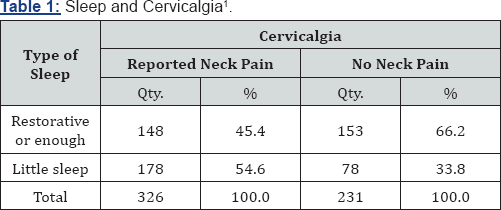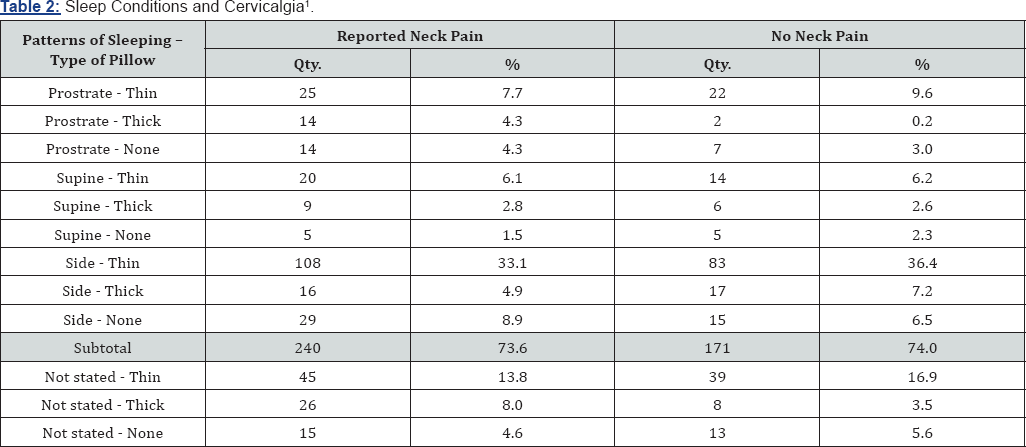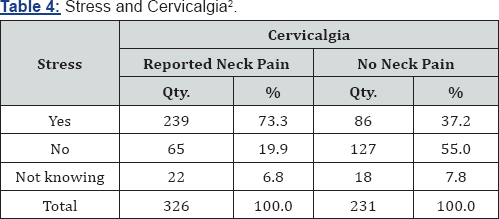Cervicalgia and its Relation to Stress in the Population of a Doctor'�'s Office-Juniper publishers
JUNIPER PUBLISHERS-OPEN ACCESS JOURNAL OF HEAD NECK & SPINE SURGERY
Abstract
Introduction: Neck pain increases its
frequency in medical consultation. It has been published that about 50%
of general population has neck pain at any time and the presence of
stress in our life is becoming increasingly frequent.
Objective: To determine the relation of neck
pain with risk factors such as stress, the posture and the perception of
risk in patients, in population older than 15 years.
Method: A, transversal, retrospective and
descriptive study was made to a representative sample of 557 persons; a
questionnaire of 10 questions was applied that included general data
with the presence of neck pain and the relation of the stress with this
pain as causal factors.
Results: 58.5% of the patients (326) reported neck pain at any time and 73.3% has stress and neck pain associated.
Conclusions: Stress is identified as an
important risk factor of the neck pain with several manifestations
present and related to this suffering.
Introduction
The pain, in general, is a complex and
multi-determined phenomenon resulting from the interaction between
physiological, psychological and socio-cultural factors [1].
It is described as an organic and emotional sensation that produces
unpleasantness or it is unpleasant; each person experiences it in a
unique way, reason for which the pain is reported and suffered in each
patient differently [2].
Cervicalgia or neck pain manifests itself in a
gradual and very irregular way, with pain in the back of the neck
spreading to the shoulders, with sensation of shoulder muscles drawing,
with the passage of time, pains spread in occipital region accompanied
by hearing sensations of instability and visual disturbances, in turn
may be accompanied by a psychic symptoms [3]. Besides, neck pain is described as a spinal pain and/or sensation of discomfort and limitation of neck movement [4,5].
In the international literature it is informed that up to 50% of the population may have neck pain at any time [6].
The three main factors affecting the adult posture of a man once he has
reached the fully upright attitude are: inheritance, disease and bad
habit. The posture is influenced by family-inherited factors in which
the attitude of parents and grandparents is transmitted to offspring. To
a large extent, the posture is the somatic image of emotions and its
organic language, an externalized expression of inner feelings. The
weary and depressed person adopts postures with back bent and slouched
posture, the neck excessively bowed and placed in front of the center of
gravity in slackened and eccentric posture, representing in that way to
feel tired, resulting fatigue, ligamentous distension that together
with the demand of muscle action produces pain and increases cervical
lordosis, hyperextension [7,8].
Hyperkinetic or tense person for lack of relaxation
does not release muscular tension and maintains in isometric contraction
muscles exerting harmful action on the functional units of neck.
Tension either emotional or physical or due to tedious activities
produces prolonged tension myalgia producing neck pain and disability [7].
Many persons do not know the correct postures both at
work and in domestic life, to sit, to move, to stand, consequently
there are no references on right and wrong postures and when you join
stress and lack of time with overexertion and poor postural attitudes,
that have to be modified, the mediate and immediate result may be
harmful; on the other hand, not recovering from the burden to which have
been submitted the previous day, i.e., not sleeping properly, not
knowing to make pauses and relaxation during the course of the day are
harmful aspects affecting men and women at any time.
In order to understand the behavior of cervicalgia as
well as the presence of risk factors such as stress and risk perception
from the study of a population in a family doctor's office, this
research was carried out with useful elements for future health actions
especially for the specialty of Physical Medicine and Rehabilitation
Universe and sample: The universe of our study
is composed by patients older than 15 years old (3485) belonging to the
doctor's office No. 6 of the Heroes del Moncada Polyclinic from the
Plaza de la Revolucion Municipality. The sample was randomly chosen
representatively according to the universe, accomplishing the criteria
of inclusion and exclusion, considering a significance level less than
5% for statistical graphs applied. The sample was calculated by
statistical procedure (epinfo) and chosen by simple random sampling
according to the distribution of the population existing in the doctor's
office.
Type of study: Observational; Descriptive; Retrospective; transversal (Appendix 1)
a) Patients older than 15 years old belonging to the
doctor's office No. 6 of the Heroes del Moncada Polyclinic in the period
under study
b) Patients who voluntarily agreed to participate in the study.
Criteria of exclusion
a) Patients with mental disorders or other different
disorders who do not contribute in the completion of the questionnaire
with the necessary information.
b) Patients who did not agree to be part of our research.
Collection of information
For the purpose of fulfilling our research an anonymous questionnaire (Appendix 2)
was applied which included 10 questions. It was prepared in the service
of Physical Medicine and Rehabilitation of the Center for Medical and
Surgical Research (CIMEQ, by its initials in Spanish). The same was
self-applied or applied by the author to chosen patients in a home visit
between July 2010-2011. In the data collection instrument it is
gathered the necessary variables for outputting the objectives proposed.
Operationalization of variables
a) Age (years completed): Continuous
Quantitative Variable with ranges (15-29 years, 30-44 years, 45-59
years, 60-74 years, 75 and more. The age groups were presented in
percent.
b) Sex: Discontinuous nominal qualitative variable, biological sex or gender (female-male). The groups were presented in percent.
c) Neck pain or Cervicalgia throughout life:
Nominal qualitative variable, presence or absence of pain at the level
of the cervical spine throughout life. It is answered Yes or No. The
results are expressed in percent.
d) Factors associated with cervical pain:
Nominal qualitative variable. Patterns of sleeping. Characteristics of
pillow and mattress. Presence of stress, identification of physical and
psychic factors related to Cervicalgia. Depending on how each question
is answered, yes or no, or brief and accurate answer The results are
expressed in percent.
Data Processing: The processing of information
collected was achieved by means of storing the information in a
database in Excel. Descriptive statistics were used. The texts were
processed with Word XP and tables and output graphs were performed in
Excel XP. The results are expressed in percent and were shown in tables
and graphics for a better analysis and comprehension. STATGRAPHICS
statistical package was used, tests of probability and significance were
applied (p < 0.05) and chi square test for the association of the
variables involved. The test of regression and correlation was used to
know whether there were relationships direct or inversely proportional
among the variables related. In all statistical tests were employed the
significance level of 5%. The concept of relative risk (RR) was employed
for the calculation of relative risk.
In conclusion, 58.5% of patients (326) reported that they have had cervical pain (neck pain) at any time.
In all age groups of the study sample, the pain of
the cervical spine is present at any time, being predominant in groups
of 45-54 years to 12.9%, followed by the group of 35-44 years to 11.5%.
It can statistically deduced that age and neck pain are significantly
associated (p = 0.0001 <<0.05). From the results of our study it
can be explained that there is a trend to increase the presence of
cervical pain mentioned as the population age increases.
It was observed that patients who sleep very little
report often that they have suffered from neck pain at any time than
those who have enough and restorative sleep. Statistically, it can
deduced that the type of sleep and neck pain are significantly
associated (p = 0.0000 <0.05) (Table 1).

90.9% of patients who did not report that they have
suffered from Cervicalgia at any time do not manifest symptoms of stress
or recognize only have one or two manifestations of the same. Those who
refer three or more manifestations of stress and have suffered from
Cervicalgia represent 28.3% more than those reporting that they do not
have had neck pain at any time. Statistically it could infered that
manifestations of stress and Cervicalgia are significantly associated (p
= 0.0000 <0.05) (Table 2).

The results provided that a risk factor for suffering
from of stress, these patients are 5.8 times more likely to suffer from
Cervicalgia at any time is to present three or more manifestations neck
pain at any time (Table 3).


It was also noted that there is more frequency of
neck pain at any time in patients under stress, representing 73.3% of
all patients with the referred Cervicalgia. It could be deduced that
stress and neck pain are significantly associated (p = 0.0000 <0.05).
Stress is a risk factor for suffering from cervical pain at any time,
with 3 times more likely to suffer from it than patients unstressed (Table 4 & 5).


It was found in the study sample 282 patients who
recognize overburdens and have suffered from neck pain at any time for
82.9%, and 173 patients who do not express to recognize the overburden
and have not had cervical pain in their life, which represent 79.7%. It
were obtained evidence demonstrating that the physical, mental or
emotional overburdens at work and in the family are closely associated
statistically (p = 0.0000 <0.05) with neck pain. The results showed
that the factors of physical, mental or emotional overburdens at work
and in the family are risk factors for developing cervical pain at any
time; the probability of the patients with these factors suffer from
this disease is being placed 4.7 times more (Table 7 & 8).


Discussion
The presence of Cervicalgia in more than 50% of the studied population coincides with reviewed studies [6,9]. In a systematic review including 552 studies of cervical pain also turned to be very common this disease through population [10].
In relation to sleep and neck pain we expected that
in a short night of sleep it would appear more the cervical disease in
comparison with those who have enough and restorative sleep. Similar
results were found in the literature of Finland and Sweden [11-13].
In the study sample predominates patterns of sleeping
and wrong type of pillows over patients who report neck pain at any
time. However, there are much less patients who reported neck pain at
any time and sleep in proper postures. From, the present study it was
stated that the ways of sleep and pillow types are not associated
significantly (p = 0.2921> 0.05) with Cervicalgia.
They were considered as correct combinations (face up with thin pillow, without a pillow on the back, and side with pillow).
In relation to Cervicalgia and stress, specifically,
we found no similar useful studies as a standard of comparison but if
there is literature describing the psychic tension and the lack of
relaxation with the damage in the cervical region [7,14].
Conclusion
a) Stress is identified as a major risk factor for neck pain with various manifestations present and related to this condition.
b) Cervicalgia reported at any time is significantly related to risk factors such as sleep and manifestations of stress.
https://juniperpublishers.com/jhnss/index.php
To know more about Open access Journals Publishers please click on : Juniper Publishers

Comments
Post a Comment